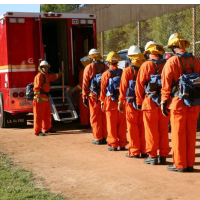Thousands of Inmates Still Fighting Fires Despite Early Release of Low-Level Felons
 Firefighting inmates in Los Angeles County (photo: California Department of Forestry and Fire Protection)
Firefighting inmates in Los Angeles County (photo: California Department of Forestry and Fire Protection)
More than 40% of the firefighters fighting blazes around the state for the California Department of Forestry and Fire Protection (Cal Fire) are inmates making $1 an hour—if they are on the front lines. Support services pay from $1.45 to $3.90 a day.
Last year, lawyers from the state Attorney General’s office argued to the courts that an earlier court-ordered revamp of parole standards to reduce prison overcrowding would hurt the fire program and didn’t want to do it. The program rewarded low-level felons with 2-for-1 credits for days-served for working.
A three-judge federal panel told the state in February 2014 they could ignore the credits “to the extent such credits do not deplete participation in fire camps.” In September, the judges revisited the issue and subsequently expressed skepticism about the state’s arguments and intentions. In December, the California Department of Corrections and Rehabilitation’s (CDCR) agreed to usher in the Apocalypse and grant the credits.
The CDCR reported that 1,883 prisoners have been released early because of the credits as of June 3, but department spokesman Bill Cessa told ThinkProgress last week, “We currently have a sufficient number of inmates so the fire protection is not compromised.” But he warned, “Over time, in theory, the inmates who are eligible to volunteer, that population should be reducing in state prison.”
Not only is that population shrinking, the shorter sentences reduces the incentive for inmates to take on dangerous firefighting work. Although the pay is good money in prison, it is paltry by most standards (civilian volunteers make $9 minimum wage). That can be an incentive for some prisoners, but it’s a huge incentive for the state to continue the program.
The Conservation Camp program, run by the CDCR and Cal Fire, trains more than 4,300 inmates for work combating fires in the state. They receive $1 an hour and time-served credit for the work. They are also utilized in other emergencies, including floods and earthquakes, and work on conservation projects on public lands and local community services projects.
Only minimum custody inmates, including juvenile offenders, are allowed to participate. The CDCR says the program inmates provide approximately 3 million hours in emergency service and 7 million hours of community service work in an average year,
The CDCR says on its website that the state saves $80 million a year by using cheap labor from the Conservation Camp. Buzzfeed calculated it’s closer to $1 billion.
When Buzzfeed reported in November that Attorney General Kamala Harris’ lawyers were arguing that prisoners should be kept in prison longer because they are a cheap source of labor, the Democratic Senate candidate said she was “shocked” to read that. She told ThinkProgress that it “evokes images of chain gangs.”
Lawyers challenging the state ridiculed an assertion (pdf) that the depleted low-level prison workforce would be irreplaceable:
“Defendants baldly assert that if the labor pool for their garage, garbage and city park crews is reduced, then ‘CDCR would be forced to draw-down its fire camp population to fill these vital MSF positions.’ That is a red herring; Defendants would not be ‘forced’ to do anything. They could hire public employees to perform tasks like garbage collection, garage work and recycling.”
To paraphrase Herman Melville’s Bartleby, the Scrivener, “They would prefer not to.”
–Ken Broder
To Learn More:
Thousands of Firefighters in California Are Inmates, Being Paid $1 an Hour on the Line (by Natasha Geiling, ThinkProgress)
30 Percent of California's Forest Firefighters Are Prisoners (by Julia Lurie, Mother Jones)
California AG “Shocked” to Learn Her Office Wanted to Keep Eligible Parolees in Jail to Work (by Adam Serwer, BuzzFeed)
State Loses Argument that Loss of Cheap Labor Is Reason Not to Parole Prisoners (by Ken Broder, AllGov California)
California’s Prison Crowding Reduction Plans and Credit Laws (Prison Law Office) (pdf)
- Top Stories
- Controversies
- Where is the Money Going?
- California and the Nation
- Appointments and Resignations
- Unusual News
- Latest News
- California Forbids U.S. Immigration Agents from Pretending to be Police
- California Lawmakers Urged to Strip “Self-Dealing” Tax Board of Its Duties
- Big Oil’s Grip on California
- Santa Cruz Police See Homeland Security Betrayal in Use of Gang Roundup as Cover for Immigration Raid
- Oil Companies Face Deadline to Stop Polluting California Groundwater





